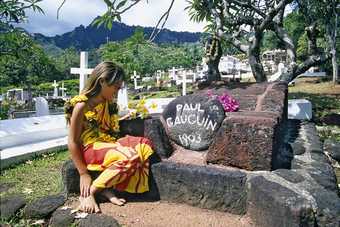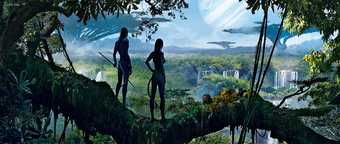
Dylan Cole
Concept artwork for Avatar 2007
Computer-generated image
© Dylan Cole and Lightstorm Entertainment
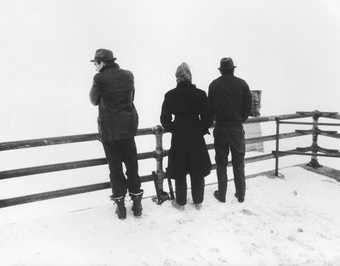
Jim Jarmusch
Stranger Than Paradise 1984
Film still
Courtesy BFI © Jim Jarmusch
In short there’s simply not
A more congenial spot
For happily-ever-aftering than here
In Camelot.
From Camelot, the 1960 Broadway musical; music and lyrics by Alan J. Lerner, book by Frederick Loewe
We were both children during the 1960s, a shade too young to revel in the Summer of Love (1967), other than through erotically vague and vicarious, Beatles-enhanced yearning. We do, however, remember the years with which that decade began in America, as vividly as we can recall the feeling of our toes in wet sand, the smell of pancakes and French toast, the heartwarming sight of our then-young and glamorous mothers and the televised vision of that Once and Future Queen of young and glamorous mid-century mothers, Jacqueline, whispering and trance-walking her way through the east wing of the White House. So, yes, forget for now the Bay of Pigs and the other near and real abominations of that age to focus for a moment on our first images of Paradise: a kaleidoscope Camelot, seen through the prism of the 1960 Broadway musical by Lerner and Loewe and the magical, if faintly satanic, glimmer of TV. It was a neurotic, compound-complex Paradise if ever there was one, which has supplied us with plenty of material, in and out of therapy, even now that we’re a shade older than the Obamas.
When we were not busy poring over the liner notes in our original cast albums of Camelot, with their sweetly kinky pictures of Richard Burton, Julie Andrews, Mordred, Morgana and the rest in chain mail accessories – or alternatively glued to after-school broadcasts of divine and even kinkier ‘antiquity’ movies that all seemed to feature Tony Curtis in the role of an early Christian – we ventured forth into our local worlds to notice some hometown paradises as well.
For Brooks, who lived in Lake Forest, Illinois, a prototypically idyllic Chicago suburb on the north shore of Lake Michigan, these included a number of architectural landmarks, civic and residential, by such architects, little known to contemporary Europe, as Howard Van Doren Shaw (the sober yet affectionate Market Square, with its red-brick arcades) and the sublimely pis-elegant David Adler (neoclassical petit palaces and grounds for those American aristocrats, titans of meat and steel). More impressive, however, to the child-Brooks than even Mrs Stanley Keith’s neo-Georgian-colonial villa, ‘a late estate-era triumph’ by Adler (with the landscapist Ferruccio Vitale, who died before the house was done), was the sight in neighbouring Wilmette of the Bahá’í Temple, designed by the French Canadian architect Louis Bourgeois (1856–1930).

The Bahá’ì Temple in Wilmette, Illinois
© Tom Johnston
If Mrs Keith’s villa suggests the double-winged US Capitol building in Washington DC, and the heady charms of Bath, Bourgeois’s dazzling white, nine-sided edifice evokes the Taj Mahal, along with the intricately filigreed patterns of the exquisite Ardabil, that definitively paradisiacal Persian rug in the collection of the Victoria and Albert Museum. The progressive Bahá’í faith, founded in Tehran in 1844 by Bahá’u’lláh, is of course itself a utopian construct to beat the band: an omnium gatherum of the more forgiving precepts of Abraham, Krishna, Moses, Zoroaster, Buddha, Christ and Muhammad, with a further exalted emphasis on the arts. Bourgeois lived for years like a saint, in a hut next to the construction site, toiling on this labour of love – still the only Bahá’í temple in the US. He died, some said of exhaustion, more than twenty years before it was completed in 1953. The transcendent inscription (in Ghazal) on the Ardabil carpet – ‘I have no refuge in this world other than thy threshold / My head has no resting place other than this doorway’ – might well have served him as an epitaph.
Elsewhere in America at this very time, Lisa was exploring on a roughly daily basis the ever-evolving paradise of Central Park, the masterwork of Frederick Law Olmsted (who was also involved in the planning of Lake Forest) and Calvert Vaux. Early on in her childhood, Eden was the geographic heart of the park, defined by the 72nd and 86th Street tranverses. Mother Goose Playground, a perilous paradise of cracked concrete and rusting steel, has long since been levelled and renamed Rumsey Playing Field. But it was the epicentre of her first idylls, most involving a fearlessly naughty red-haired boy named Kerry, the son of a famous right-wing gossip columnist of the day. There they would be, unseen together, in a vine-covered arbour abutting the playground, the notorious haunt of pushers and flashers, in an imminent dystopia. Greater safety lay on the far side of the 72nd Street transverse, on the broad bronze shoulders of Alice in Wonderland, a sculptural group featuring most of the story’s characters and a great big mushroom, which was unveiled in 1959 and signed Jose de Creeft.
Deeper in the park and into childhood, the centre shifted to the area around Belvedere Castle, a storybook-Gothic turreted vision on Vista Rock, overlooking Turtle Pond. Created in 1869 by Vaux, with Jacob Wrey Mould, as a Victorian folly, it eventually began to earn its keep: outfitted in 1919 with meteorological equipment, it is where New York City official temperatures are recorded to this day. The castle also moonlights in the theatre, and has by now served as backdrop to most of Shakespeare’s plays, which are presented on summer evenings at the Delacorte Theater, on the west bank of the pond.
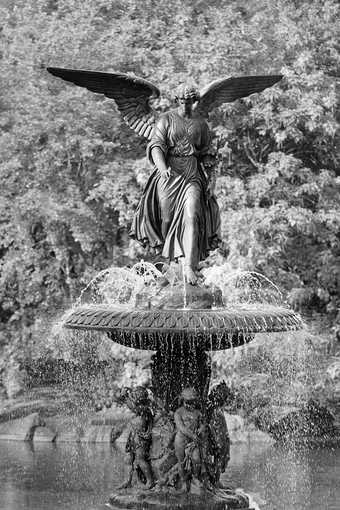
Angel of the Waters fountain on the Bethesda Terrace in Central Park, New York, designed by Emma Stebbins in 1868
© Winston Davidian
Adolescence began – alas – at the end of the decade, and its focus was not the picturesque. Lisa’s early teenage years unfolded under the absent gaze of the winged Beaux-Arts angel of Bethesda Fountain, designed by Emma Stebbins, the first woman to receive an official sculptural commission in New York, and unveiled in 1873 when Central Park was officially ‘complete’. There, to the rhythm of drumbeats and the scent of unshared pot, just across the lake with its rowboats from the infamous Ramble, she perused the long-haired hordes of beaded boys, not knowing Mordred from Lancelot.
Now the Ramble has grown up into an urban jungle,
and lurking in its thickets are hoods, hobos, hustlers,
and homosexuals, and other estranged creatures of the
city…
Robert Smithson, from Frederick Law Olmsted and the Dialectical Landscape (1973), the artist’s treatise against the nineteenth-century concept of the picturesque, in favour of a continually evolving urban fabric.They paved paradise,
And put up a parking lot,
With a pink hotel, a boutique
And a swinging hot spot.
Joni Mitchell, from the album Ladies of the Canyon (1970)

Robert Altman
Photograph of the Holy Man Jam, Boulder, Colorado 1970
Photo: Robert Altman
Between the twin poles of Smithson’s euphoric dystopia (a crime-ridden and nearly bankrupt New York), and the utopian pathos of Mitchell’s deathless lyrics (post-Manson-murders Los Angeles), sprawled the wildly paradoxical American 1970s, along with our coming of age. Whether ‘divine decadence’ or political engagement, modern dance at the Judson Church Theater or Saturday Night Fever (1977), Tom of Finland’s superstuds-in-leather, Gordon Parks Jr’s Super Fly (1972) or Russ Meyer’s Supervixens (1975) – à chacun son paradis (to each his own paradise). In Manhattan and well-acquainted by the middle of the decade, the two of us careened about, alone and together, in the Big (Bad) Apple – like a supersized Diagon Alley full of muggers and bag ladies, witches and wizards, after-hours clubs and avant-garde hip-hop – finding occasional refuge in opera houses and galleries of contemporary art.
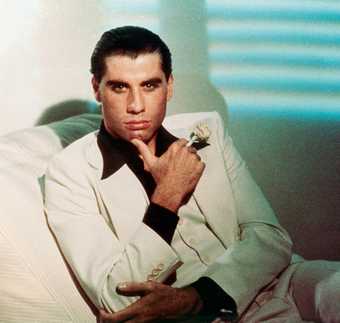
John Travolta as Tony Manero in Saturday Night Fever 1977
Film still
Courtesy Everett Collection/Rex Features
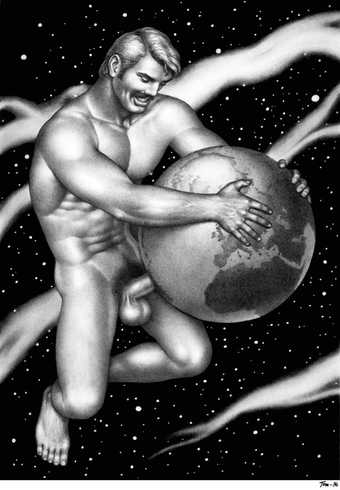
Tom of Finland (aka Touko Laaksonen)
Untitled 1976
Graphite on paper
© Tom of Finland Foundation, Los Angeles
A newly energised art world had indeed ensnared us by the late 1970s, and although artists of our generation were rapidly coming to the fore, none offered as shimmering a vision of paradise – through his opera sets, along with his paintings and graphics – as the great David Hockney, that erstwhile fanciullo del West. Brooks had been living since college with an expensively shrink-wrapped Hockney swimming pool poster issued for the (doomed) 1972 Munich Olympics.

David Hockney
Mullholland Drive, The Road to the Studio 1980
Acrylic on canvas
218.4 x 617.2 cm
Courtesy Los Angeles County Museum of Art © David Hockney
Then, of course, there was A Bigger Splash 1974, Jack Hazan’s idyllic film portrait (named after Hockney’s seminal 1967 pool painting) of the artist and his – ah, what a lifestyle! The very street names of Los Angeles – invoked and embodied by Hockney’s Mulholland Drive (1980) – were the stuff of dreamscapes from the far-away vantage of low-rent New York. And by the time Lisa was invited to attend the opening, during the winter of 1980–1981, of the wonderful Hockney-designed Stravinsky-Poulenc-Ravel triple bill at the Met, the seduction was complete for her as well.
There was a time when meadow, grove, and stream,
The earth, and every common sight,
To me did seem
Apparell’d in celestial light,
The glory and the freshness of a dream.
It is not now as it hath been of yore; –
Turn wheresoe’er I may
By night or day,
The things which I have seen I now can see no more.William Wordsworth (1770–1850), from Ode 536: Intimations of Immortality from Recollections of Early Childhood
Enter the 1980s, followed by Death and the ‘Erotic Frigidaire’ – to use a term coined by Mario Praz (1896–1982) on the subject of Antonio Canova. During the course of this particularly drawn out decade, as contemporary art increasingly signified money, and a community of ghosts, forever young, gathered in force, our paths for a while seemed to diverge. Brooks had embarked upon the high road of neoclassicism, to experience the decidedly chilled thrills of works by Canova, John Flaxman and J-L David, while Lisa got on cheap flights to Europe whenever she could, for instance to biennales and Documentas. But gazing across the lagoon at Venice’s Isola di San Michele (and thinking of Arnold Böcklin’s various Isles of the Dead, 1880–6), or strolling through Kassel’s rebuilt eighteenth-century Fridericianum (especially in 1982, with its Rudi Fuchs-curated corri d’oro of latter-day classical works by artists such as Giulio Paolini, Giovanni Anselmo, Sigmar Polke and Cy Twombly) she had walked into the Frigidaire, too. As (at last!) the decade turned, we were usually together – often in Belgium, on the trail now of Symbolism, James Ensor and the carnivalesque.
But a certain static melancholy gradually gave way to the idea of shared dreamscapes – many, unsurprisingly, in Italy – including Adalberto Libera’s Casa Malaparte (1937) on Capri (not to mention Jean-Luc Godard’s Contempt, from 1963, which was filmed there); the Museo Canoviano in Possagno, in the Veneto, with its 1955–7 Carlo Scarpa addition, along with the swallows (and the Cipriani Ho- tel) of the nearby town of Asolo; the never-consecrated Capella delle Brunate, perched among the vineyards outside of Alba, with its bold 1999 exterior wall painting by Sol LeWitt; pretty much all of Venice, of course; but also the abandoned train tracks on the southern edge of Paris, where we’ve been living; and the less trammelled northern rather than central swathe of Central Park, to which we will perhaps return.
Bali Ha’i may call you,
Any night, any day,
In your heart, you’ll hear it call you,
‘Come away… come away.’
BaliHa’i will whisper
In the wind of the sea:
‘Here I am, your special island!
Come to me, come to me!’
From the 1949 Broadway musical South Pacific by Richard Rodgers and Oscar Hammerstein
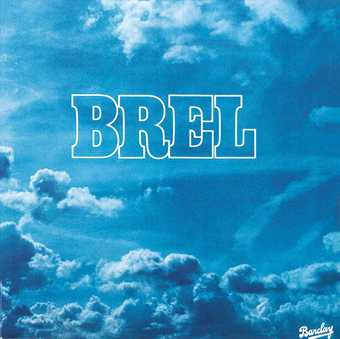
Cover of Jacques Brel’s album Brel, released in 1977
Courtesy Brel Foundation, Brussels
As perhaps you’ll agree, our separate and combined notions of paradise (and we’ve left out quite a few) are, to say the very least, syncretic: bits and pieces of this and that, joyful and not, seen through the prism of what has become each of our ongoing, rather chaotic presents. We will even go as far as to include the Barbican, “the brutalist paradise in the City of London”, according to a recent article in the Financial Times bearing the headline ‘No one wants to move out’. The artist Robert Hawkins, Lisa’s friend and fellow New Yorker during the 1980s, has been living there for a decade or more, and he’s certainly had an angelic smile on his devilish face every time we’ve run into him. Before a Cheek by Jowl performance there this spring of Macbeth, we stepped out along the Barbican’s long, wide inner-court pools to have a look. And despite those drooling humidity stains on extra-rough concrete, we did not find it wanting. But neither of us has ever felt that paradise had anything at all to do with the South Pacific, apart from – arguably – the musical, and of course Marlon Brando, the great Jacques Brel and Paul Gauguin.
They speak of death the way you’d speak of a fruit /
They look to sea as you’d peer into a sluice /
The women lie open to the all-powerful sun /
And that it’s not winter doesn’t mean summer fun /
The rain drives hard and pounds with every drop /
Some old white horses humming Gauguin at rather less than a trot /
And that there’s no wind only seems to make time freeze /
In the Marquesas.
From Jacques Brel’s The Marquesas on the 1976 album Brel (translated from the French by Lisa Liebmann). The song was written on Hiva Oa, in the Atuona archipelago of the Marquesas Islands, a year before he died. He is buried there, very near the grave of Paul Gauguin

